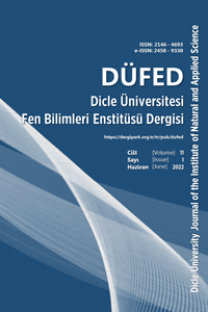Yeraltı Sularından Biyolojik Nitrat Giderimde Kullanılan Reaktör Tipleri
Reactor types used in biological nitrate removal from groundwater
Nitrate removal Biological Methods, Heterotrophic denitrification, Autotrophic denitrification,
___
- Ş. Aslan, A. Türkman, 2003. “İçme sularindan biyolojik denitrifikasyon yöntemiyle nitrat gideriminde ortam koşullarinin etkisi,” Dokuz Eylül Üniversitesi Mühendislik Fakültesi Fen ve Mühendislik Dergisi 5, 17-25.
- [2] D. Ucar, Cokgor, E. U., Sahinkaya, E., Cetin, U., Bereketoglu, C., Calimlioglu, B. Yurtsever, A. 2017, "Simultaneous nitrate and perchlorate removal from groundwater by heterotrophic-autotrophic sequential system,” Int. Biodeterior. Biodegradation, 116, 83–90.
- [3] M. I. Yesilnacar, M. S. Gulluoglu, 2008. “Hydrochemical characteristics and the effects of irrigation on groundwater quality in Harran Plain, GAP Project, Turkey,” Environ. Geol. 54, 183–196,
- [4] M. I. Yesilnacar, E. Sahinkaya, M. Naz, B. Ozkaya, 2008. “Neural network prediction of nitrate in groundwater of Harran Plain, Turkey,” Environ. Geol., 56, 19–25,
- [5] H. Il Park, D. K. Kim, Y.-J. Choi, D. Pak, 2005. “Nitrate reduction using an electrode as direct electron donor in a biofilm-electrode reactor,” Process Biochem., 40, 3383–3388.
- [6] H. S. Moon, S. W. Chang, K. Nam, J. Choe, J. Y. Kim, 2006. “Effect of reactive media composition and co-contaminants on sulfur-based autotrophic denitrification,” Environ. Pollut., 144, 3, 802–807,
- [7] C. Della Rocca, V. Belgiorno, S. Meriç, 2007. “Overview of in-situ applicable nitrate removal processes,” Desalination, 204, 1-3, 46–62,
- [8] D. Ucar, E. U. Cokgor, E. Şahinkaya, 2016. “Simultaneous nitrate and perchlorate reduction using sulfur-based autotrophic and heterotrophic denitrifying processes,” J. Chem. Technol. Biotechnol., 9, 5, 1471–1477,
- [9] H. S. Moon, D. Y. Shin, K. Nam , J. Y. Kim, 2008. “A long-term performance test on an autotrophic denitrification column for application as a permeable reactive barrier,” Chemosphere, 73, 723–728,
- [10] R. Sierra-Alvarez, R. Beristain-Cardoso, M. Salazar, J. Gomez, E. Razo-Flores, J. A. Field, 2007. “Chemolithotrophic denitrification with elemental sulfur for groundwater treatment,” Water Res., 41, 1253–1262,
- [11] V. Matějů, S. Čižinská, J. Krejčí, T. Janoch, 1992. “Biological water denitrification—a review,” Enzyme Microb. Technol., 14, 3, 170–183,
- [12] E. Sahinkaya, A. Yurtsever, Ö. Aktaş, D. Ucar, Z. Wang, 2015. “Sulfur-based autotrophic denitrification of drinking water using a membrane bioreactor,” Chem. Eng. J., 268, 180–186,
- [13] E. Sahinkaya, A. Yurtsever, D. Ucar, 2017. “A novel elemental sulfur-based mixotrophic denitrifying membrane bioreactor for simultaneous Cr(VI) and nitrate reduction,” J. Hazard. Mater., 324, 2, 15–21,
- [14] A. Kilic, E. Sahinkaya, O. Cinar, 2014. “Kinetics of autotrophic denitrification process and the impact of sulphur/limestone ratio on the process performance,” Environ. Technol., 35, 22, 2796–2804,
- ISSN: 2146-4693
- Yayın Aralığı: Yılda 2 Sayı
- Başlangıç: 2012
- Yayıncı: Dicle Üniversitesi
Karbon Fiber Takviyeli Kompositlerin Düşük Sıcaklıklarda Düşük Hızdaki Darbe Dayanımı
Zafer ÖZDEMİR, Selim TÜRKBAS, Dilara YILMAZ
Mustafa İLÇİN, Ali SATAR, Sadreddin TUSUN
Derik İlçesinde (Mardin) Soya Fasulyesi Alanlarında Bulunan Zararlı Böcek Türleri
Cihan YARDIM, Selime ÖLMEZ BAYHAN
Yeraltı Sularından Biyolojik Nitrat Giderimde Kullanılan Reaktör Tipleri
